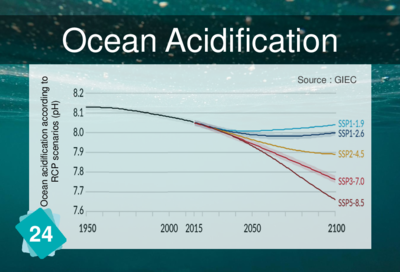En-en adult card 24 ocean acidification: Difference between revisions
Jump to navigation
Jump to search
m (Minor corrections) |
No edit summary |
||
| Line 4: | Line 4: | ||
|title=Ocean Acidification | |title=Ocean Acidification | ||
}}<ref>[https://www.ipcc.ch/site/assets/uploads/2018/03/WG1AR5_SummaryVolume_FINAL_FRENCH.pdf#page=110 Page 95 of the Technical Summary of the 5th IPCC Report (French)]</ref> | }}<ref>[https://www.ipcc.ch/site/assets/uploads/2018/03/WG1AR5_SummaryVolume_FINAL_FRENCH.pdf#page=110 Page 95 of the Technical Summary of the 5th IPCC Report (French)]</ref> | ||
== Correction== | |||
===Causes=== | |||
* [[En-en_adult_card_12_carbon_sinks|Carbon Sinks]] | |||
=== Consequences === | |||
* [[En-en_adult_card_23_hindered_calcification_process|Hindered Calcification Process]] | |||
== Explanation == | == Explanation == | ||
Revision as of 11:37, 5 April 2021
Card #24: Ocean Acidification
| Causes | Consequences | |

|
When CO2 dissolves into the ocean, it turns into acid ions (H2CO3 and HCO3–).
The effect of this transformation is ocean acidification (the pH decreases).
Correction
Causes
Consequences
Explanation
Ocean acidification is sometimes referred to as "the other carbon problem". It is not strictly speaking a consequence of climate change, but another consequence of CO2 emissions.
Facilitation advice
Frequently mentioned link
The card Concentration of CO2 (ppm) is often identified as the precursor of this card. However, not every molecule that is found in the ocean was previously in the atmosphere, and therefore the most logical link is with the carbon sinks card.